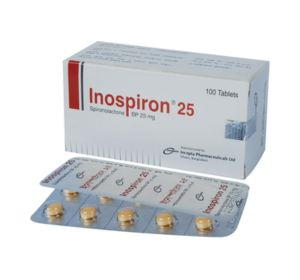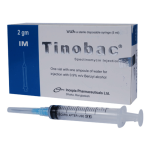Inospiron(Spironolactone)

Therapeutic Group: Cardiovascular
Presentation
Inospiron 25: Each tablet contains Spironolactone BP 25 mg.
Inospiron 100 : Each tablet contains Spironolactone BP 100 mg.
Description
Spironolactone is a long-acting aldosterone antagonist and potassium-sparing diuretic. It acts primarily through competitive binding of receptors at the aldosterone dependent sodium-potassium exchange site in the distal convoluted renal tubule. Spironolactone causes increased amount of sodium and water to be excreted, while potassium and magnesium are retained.
Indications
Essential hypertension
Congestive heart failure
Hepatic cirrhosis with ascites and edema
Nephrotic syndrome
Primary hyperaldosteronism
For the treatment of patients with hypokalemia
Dosage & Administration
Essential hypertension: For adults, an initial daily dose is 50 mg to 100 mg administered in either single or divided doses.
Edema in adults (congestive heart failure, hepatic cirrhosis, or nephrotic syndrome): An initial daily dosage of 100 mg of Inospiron® administered in either single or divided doses is recommended, but may range from 25 to 200 mg daily. Combined therapy with other diuretics is indicated when more rapid diuresis is desired.
Primary hyperaldosteronism: After the diagnosis of hyperaldosteronism has been established, Inospiron® may be administered in doses of 100 to 400mg daily in preparation for surgery. For patients who are considered unsuitable for surgery, Inospiron® may be employed for long-term maintenance therapy at the lowest effective dosage determined for the individual patient.
Essential hypertension: For adults, an initial daily dosage of 50 to 100 mg of Inospiron® administered in either single or divided doses is recommended.
Hypokalemia: Inospiron® in a dosage ranging from 25 mg to 100 mg daily is useful in treating a diuretic-induced hypokalemia.
Side Effects
Gynaecomastia may develop in association with the use of Spironolactone. Other adverse reactions are: GI symptoms including cramping and diarrhoea, drowsiness, lethargy, headache, urticaria, mental confusion, impotence, irregular menses or amenorrhoea and post-menopausal bleeding.
Precautions
All patients receiving diuretic therapy should be observed for evidence of fluid or electrolyte imbalance. Hyperkalemia may occur in patients with impaired renal function or excessive potassium intake and can cause cardiac irregularities, which may be fatal.
Use in Pregnancy & Lactation
Pregnancy: Spironolactone should not be used during pregnancy.
Lactation: Canrenone, an active metabolite of Spironolactone, appears in breast milk. If use of the drug is deemed essential an alternative method of infant feeding should be instituted.
Drug Interaction
ACE inhibitors: Concomitant administration of ACE inhibitors with potassium-sparing diuretics has been associated with severe hyperkalemia.
Alcohol, barbiturates, or narcotics: Potentiation of orthostatic hypotension may occur.
Corticosteroids, ACTH: Intensified electrolyte depletion, particularly hypokalemia, may occur.
Lithium: Lithium generally should not be given with diuretics. Diuretic agents reduce the renal clearance of lithium and add a high risk of lithium toxicity.
Digoxin: Spironolactone has been shown to increase the half-life of digoxin.
Over Dose
Symptoms of overdosage include drowsiness, mental confusion, dizziness, diarrhea and vomiting etc. Patients should induce vomiting or evacuate the stomach by lavage during Spironolactone overdoasge.
Storage
Do not store above 30°C. Keep out of the reach of children.
Commercial Pack
Inospiron 25: Each box contains 10 blister strips of 10 tablets.
Inospiron 100: Each box contains 3 blister strips of 10 tablets.



